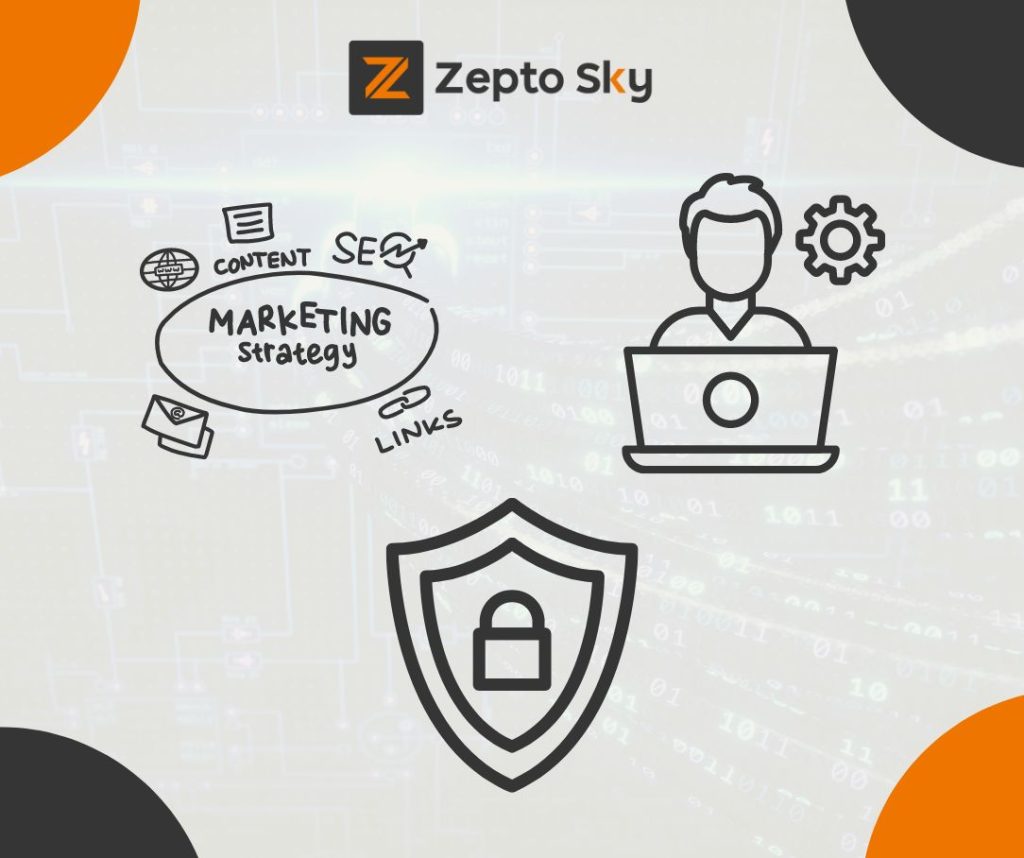Technology is evolving rapidly, driving faster changes and progress, and accelerating innovation. This evolution impacts technological trends and the broader landscape, prompting IT professionals to recognize that their roles will keep evolving in a contactless world.
With the digital world changing fast, it is important for most companies to ride on the latest IT trends to keep themselves in the competition and modern companies need to be innovative as well. IT trends are a kind of where the Current technological directions and developments are shaping the way businesses operate. Companies need to keep up with these trends to benefit from new opportunities, and efficiency and stay in front of the competition.
What are IT Trends?
IT trends are the latest technological advancements and practices shaping the information technology landscape. These trends include innovations like artificial intelligence (AI), cloud computing, cybersecurity, Internet of Things (IoT), and blockchain technology. Staying updated with IT trends is crucial for businesses to improve efficiency, enhance security, and remain competitive. For companies in cities like Sydney, partnering with local experts such as a reputable IT company, digital marketing service, or software development company can help leverage these trends effectively. Adopting these trends ensures that businesses stay ahead in the fast-paced digital world.
Importance of Staying Updated with IT Trends
Staying updated with IT trends is crucial for businesses in today’s fast-paced digital world. Keeping up with the latest technologies like AI, cloud computing, and cybersecurity helps companies improve efficiency and enhance security. For example, a Software Development Company in Sydney can streamline operations with the latest tools, while cybersecurity companies can better protect against evolving threats.

Adopting new IT trends also gives businesses a competitive edge, allowing them to innovate and improve customer experiences with technologies like IoT and AI chatbots. Additionally, staying current ensures businesses remain relevant and adaptable to market changes. For a Digital Marketing Company in Sydney, leveraging big data analytics can lead to more effective marketing strategies and higher engagement.
In summary, keeping up with IT trends is crucial for boosting growth, enhancing security, and staying competitive in the constantly changing digital world.
Artificial Intelligence and Machine Learning in Business
Artificial Intelligence (AI) and Machine Learning (ML) are rapidly transforming the business landscape, providing companies with new ways to grow and innovate. By leveraging these technologies, businesses can automate processes, gain valuable insights, and improve customer experiences. Here’s how AI and ML are growing and affecting businesses.
How Artificial Intelligence and Machine Learning Are Transforming Business Operations
Artificial Intelligence and Machine Learning are revolutionizing business operations in several ways:
- Automation: AI and ML can automate repetitive tasks, freeing up employees to focus on more strategic activities. For instance, AI-powered chatbots handle customer service inquiries, providing quick responses and freeing up human agents for more complex issues. This is particularly beneficial for a Digital Marketing Company in Sydney, where efficient customer service is crucial.
- Data Analysis: These technologies analyze vast amounts of data to uncover patterns and insights. Businesses can use this information to make informed decisions, improve strategies, and predict future trends. For example, a Software Development Company in Sydney might use ML algorithms to analyze user behavior and optimize their software accordingly.
- Personalization: AI and ML enable personalized customer experiences by analyzing individual preferences and behaviors. Retailers use these technologies to recommend products based on past purchases and browsing history, enhancing customer satisfaction and driving sales.
Examples of Artificial Intelligence and Machine Learning in Business
- Customer Service: AI chatbots provide instant support, answering common questions and solving problems quickly. For example, a bank might use an AI chatbot to assist customers with account inquiries, reducing wait times and improving service.
- Healthcare: In healthcare, AI and ML are used to analyze patient data and predict health issues. A hospital might implement an AI system to identify patients at risk of certain conditions, allowing for early intervention and better outcomes.
- Finance: Financial institutions use AI for fraud detection and risk management. By analyzing transaction patterns, AI systems can identify suspicious activity and alert security teams before significant damage occurs.
- Retail: Retailers use AI to manage inventory and forecast demand. For instance, a clothing store might use ML algorithms to predict which items will be popular in the upcoming season, ensuring they stock the right products.
Benefits of Integrating Artificial Intelligence and Machine Learning
Integrating AI and ML into business operations offers numerous benefits:
- Increased Efficiency: Automation of routine tasks boosts efficiency and allows employees to focus on more strategic activities. This is especially useful for a Digital Marketing Service in Sydney, where time-consuming tasks like data analysis and reporting can be automated.
- Cost Savings: By reducing the need for manual labor and minimizing errors, AI and ML can lead to significant cost savings. Businesses can invest these savings in other areas, such as innovation and expansion.
- Enhanced Decision-Making: AI and ML provide data-driven insights that enhance decision-making. Companies can make informed choices, leading to better strategies and improved outcomes.
- Improved Customer Experience: Personalized interactions and faster response times enhance the customer experience, leading to higher satisfaction and loyalty.
- Innovation: AI and ML drive innovation by enabling new products, services, and business models. For instance, a blockchain developer might use AI to enhance security and efficiency in blockchain applications.
The Rise of Cloud Computing Solutions
Cloud computing offers a plethora of benefits for businesses, making it a preferred choice for modern organizations. Here’s a detailed look at why companies are increasingly embracing cloud computing solutions:
Scalability in IT
Cloud computing provides unparalleled scalability, allowing businesses to adjust their resources according to fluctuating demand. Whether experiencing sudden spikes or seasonal variations in workload, companies can effortlessly scale their computing resources up or down without the need for hefty infrastructure investments. This scalability ensures optimal performance and resource utilization, enabling businesses to meet customer demands efficiently.
Flexibility in IT
The flexibility offered by cloud computing revolutionizes how employees work and collaborate. With cloud-based solutions, employees gain access to data and applications from any location with an internet connection. This flexibility empowers remote work and enables seamless collaboration among distributed teams. By breaking the barriers of traditional office environments, businesses can foster a culture of productivity and innovation while accommodating the evolving needs of modern workforces.
Cost Savings
One of the most significant advantages of cloud computing is its ability to drive cost savings for companies. By eliminating the need for on-premises hardware and infrastructure maintenance costs, cloud computing significantly reduces IT expenses. Companies can avoid upfront capital expenditures associated with purchasing and maintaining physical servers, as well as the costs of cooling and powering data centers. Instead, they pay only for the resources they use on a pay-as-you-go basis, resulting in substantial cost savings over time.
Improved Security
Security is paramount in today’s digital landscape, and cloud computing offers robust security measures to protect sensitive data and applications. Cloud service providers invest heavily in security technologies and protocols, ensuring data protection and encryption at multiple levels. From physical security measures at data centers to advanced cybersecurity solutions, cloud providers implement comprehensive security strategies to safeguard against cyber threats and ensure compliance with industry regulations. This level of security reassures businesses that their data is protected, mitigating risks of data breaches and unauthorized access.
Cybersecurity, A Critical Component of IT Strategy
In today’s digital world, cybersecurity is essential for safeguarding businesses from various online threats and protecting sensitive information. Let’s explore why cybersecurity is crucial and how companies can enhance their defenses:
Current Cybersecurity Threats
Cybersecurity threats are constantly evolving, posing significant risks to businesses worldwide. Common threats include:
- Malware: Malicious software designed to damage or disrupt computer systems, steal data, or gain unauthorized access.
- Phishing: Deceptive emails or messages used to trick individuals into revealing sensitive information, such as passwords or financial details.
- Ransomware: Malware that encrypts files or locks computer systems, demanding payment for their release.
- Data Breaches: Unauthorized access to confidential information, resulting in data theft or exposure.
Best Practices for Enhancing Cybersecurity
To strengthen cybersecurity defenses, companies should implement the following best practices:
- Employee Training: Educate employees about cybersecurity risks and train them to recognize and avoid common threats like phishing attacks.
- Strong Passwords: Enforce the use of complex passwords and implement multi-factor authentication to enhance account security.
- Regular Updates: Keep software, operating systems, and security patches up to date to address vulnerabilities and prevent exploitation by cyber attackers.
- Data Encryption: Encrypt sensitive data both in transit and at rest to protect it from unauthorized access.
- Access Control: Limit access to sensitive information and systems only to authorized individuals, reducing the risk of data breaches.
Tools and Technologies for Cyber Defense
Numerous tools and technologies are available to bolster cybersecurity defenses, including:
- Firewalls: Network security devices that monitor and control incoming and outgoing traffic, preventing unauthorized access and protecting against cyber threats.
- Antivirus Software: Programs that detect, prevent, and remove malware infections from computer systems, safeguarding against various types of malicious software.
- Intrusion Detection Systems (IDS): Security systems that monitor network or system activities for suspicious behavior or policy violations, alerting administrators to potential threats.
- Encryption Software: Tools that encrypt data to protect it from unauthorized access or interception, ensuring confidentiality and integrity.
In conclusion, prioritizing cybersecurity is vital for businesses to mitigate risks, protect sensitive information, and maintain trust with customers. By staying vigilant, implementing best practices, and leveraging advanced tools and technologies, companies can strengthen their cyber defenses and safeguard against evolving cyber threats.
The Impact of Big Data and Analytics
Big data and analytics have revolutionized how businesses operate, offering valuable insights that drive growth and innovation. Let’s explore their impact in simple terms:
Harnessing Big Data for Business Growth
Big data refers to the vast amounts of structured and unstructured data generated by businesses. By harnessing this data through analytics, companies can gain valuable insights into customer behavior, market trends, and operational performance. This enables informed decision-making, targeted marketing strategies, and improved operational efficiency, ultimately driving business growth.
Data Analytics Tools and Techniques
Data analytics involves analyzing and interpreting data to uncover patterns, trends, and correlations. Various tools and techniques, such as data mining, machine learning, and statistical analysis, are used to extract actionable insights from big data. These insights empower businesses to make data-driven decisions and optimize processes for better outcomes.
Predictive Analytics: Forecasting Future Trends
Predictive analytics uses historical data and statistical algorithms to forecast future trends and outcomes. By analyzing past patterns and behaviors, businesses can anticipate customer preferences, market demands, and potential risks. This enables proactive decision-making and strategic planning, helping companies stay ahead of the competition and adapt to changing market dynamics.
The Growing Importance of the Internet of Things (IoT)
The Internet of Things (IoT) is reshaping industries worldwide, offering innovative solutions to traditional challenges. Let’s explore its significance in simple terms:
How IoT is Revolutionizing Various Industries
IoT connects devices and sensors to the internet, enabling real-time data exchange and automation. This revolutionizes industries like manufacturing, healthcare, and transportation by enhancing efficiency, productivity, and safety. For example, IoT-enabled sensors in manufacturing equipment monitor performance and predict maintenance needs, reducing downtime and costs.
Key IoT Applications for Businesses
Businesses leverage IoT for various applications, including asset tracking, smart buildings, and predictive maintenance. For instance, retailers use IoT-enabled inventory management systems to track stock levels and prevent stockouts, ensuring seamless operations and customer satisfaction.
Challenges and Solutions in IoT Implementation
Despite its benefits, IoT implementation faces challenges like security concerns and interoperability issues. However, businesses can address these challenges through robust cybersecurity measures and standardization efforts. By prioritizing security and collaboration, companies can overcome obstacles and fully harness the transformative potential of IoT.
Blockchain Technology
Blockchain technology extends far beyond cryptocurrencies, offering innovative solutions to various business challenges. Let’s delve into its applications and benefits:
Blockchain Use Cases in Business
Businesses utilize blockchain for diverse applications such as supply chain management, digital identity verification, and smart contracts. For example, blockchain enables transparent and traceable supply chains, reducing counterfeit products and enhancing trust among stakeholders.
Benefits of Blockchain for Data Security
Blockchain enhances data security by providing immutable and decentralized ledgers. This ensures data integrity and prevents unauthorized tampering or modification. Businesses can rely on blockchain for secure transactions, identity verification, and confidential data sharing, reducing the risk of data breaches and fraud.
Future Prospects of Blockchain Technology
The future of blockchain technology holds immense promise, with potential applications in healthcare, voting systems, and decentralized finance. As blockchain continues to evolve, businesses can expect improved scalability, interoperability, and integration with emerging technologies like AI and IoT, unlocking new opportunities for innovation and growth.
Adopting 5G Technology for Enhanced Connectivity
5G technology is revolutionizing connectivity, offering unprecedented speed, reliability, and responsiveness. Let’s explore its overview, benefits, and industry examples:
Overview of 5G Technology
5G is the fifth generation of wireless technology, enabling faster data transfer rates, lower latency, and greater network capacity. It utilizes advanced technologies like mmWave and beamforming to deliver high-speed internet access and support a wide range of applications.
Benefits of 5G for Modern Companies
Modern companies benefit from 5G technology in various ways, including faster download/upload speeds, improved network reliability, and enhanced connectivity for IoT devices. This enables real-time communication, seamless collaboration, and efficient operations, driving productivity and innovation.
Industry Examples of 5G Integration
Numerous industries integrate 5G technology to enhance their operations. For instance, healthcare facilities use 5G for remote patient monitoring and telemedicine services, while manufacturing companies leverage 5G-enabled IoT devices for predictive maintenance and automation. Additionally, smart cities deploy 5G networks for traffic management, public safety, and environmental monitoring, improving the quality of life for residents.
adopting 5G technology offers modern companies unparalleled connectivity and transformative growth opportunities. By harnessing the benefits of 5G and leveraging industry examples, businesses can stay competitive and thrive in the digital age.
Remote Work Technologies and Digital Transformation
Remote work technologies play a crucial role in the digital transformation of businesses, reshaping how teams collaborate and operate. Let’s explore the tools, impact, and strategies associated with remote work:
Tools Facilitating Remote Work
Remote work tools like video conferencing platforms, project management software, and cloud-based collaboration tools enable seamless communication and collaboration among remote teams. These tools empower employees to work efficiently from anywhere with an internet connection.
Impact of Remote Work on Company Culture
Remote work has a significant impact on company culture, influencing communication dynamics, employee engagement, and work-life balance. While it fosters flexibility and autonomy, it also challenges traditional notions of workplace culture, requiring companies to adapt and evolve their culture to support remote work environments.
Strategies for Effective Remote Team Management
Effective remote team management requires clear communication, goal setting, and support mechanisms. Managers should establish regular check-ins, set clear expectations, and provide resources and training to support remote team members. Additionally, fostering a sense of belonging and camaraderie through virtual team-building activities can enhance collaboration and morale among remote teams.
Augmented Reality (AR) and Virtual Reality (VR) in Business
Augmented Reality (AR) and Virtual Reality (VR) are transforming how businesses engage with customers and innovate in various industries. Let’s explore their applications, impact on customer engagement, and future trends:
Business Applications of AR and VR
AR and VR find applications across industries such as retail, education, and healthcare. Businesses use AR for virtual product try-ons, interactive training simulations, and remote assistance, while VR creates immersive experiences for training, virtual tours, and design visualization.
Enhancing Customer Engagement with AR/VR
AR and VR enhance customer engagement by providing immersive and interactive experiences. Businesses use AR for virtual product demonstrations and interactive marketing campaigns, while VR offers virtual tours and immersive storytelling experiences, captivating customers and driving brand engagement.
Future Trends in AR/VR Technology
Future trends in AR and VR include advancements in hardware, software, and content creation. With the rise of augmented reality glasses and improved VR headsets, businesses can expect more immersive and realistic experiences. Additionally, innovations in content creation tools and AR/VR applications will drive adoption and integration into various business processes.
AR and VR technologies offer businesses innovative ways to engage customers, drive brand loyalty, and stay ahead in the digital age. By embracing these technologies and staying updated on future trends, companies can unlock new opportunities for growth and innovation.
Embracing IT Trends for Competitive Advantage
In today’s rapidly evolving digital landscape, embracing IT trends is essential for businesses to gain a competitive edge and thrive in the ever-changing market. Let’s summarize the key takeaways from our exploration of IT trends:
Summary of Key IT Trends
We’ve discussed various IT trends, including artificial intelligence (AI), cloud computing, cybersecurity, big data analytics, IoT, blockchain, 5G technology, remote work technologies, and AR/VR. These trends offer businesses innovative solutions for efficiency, security, connectivity, and customer engagement.
Steps to Integrate IT Trends into Business Strategy
To integrate IT trends into business strategy, companies should:
- Stay informed about the latest IT developments and trends.
- Assess their business needs and identify which IT trends align with their goals.
- Invest in training and development to upskill employees in relevant technologies.
- Collaborate with technology partners and experts to implement IT solutions effectively.
- Continuously monitor and evaluate the impact of IT initiatives on business performance.
Conclusion: Staying Ahead in the IT Landscape
Looking ahead, businesses must remain agile and adaptive to stay ahead in the IT landscape. By embracing emerging technologies, fostering a culture of innovation, and prioritizing cybersecurity, companies can position themselves for success in the digital age.
In conclusion, by embracing IT trends and leveraging them strategically, businesses can unlock new opportunities, drive innovation, and maintain a competitive advantage in today’s dynamic business environment. It’s time to embrace the future of technology and pave the way for sustainable growth and success.





